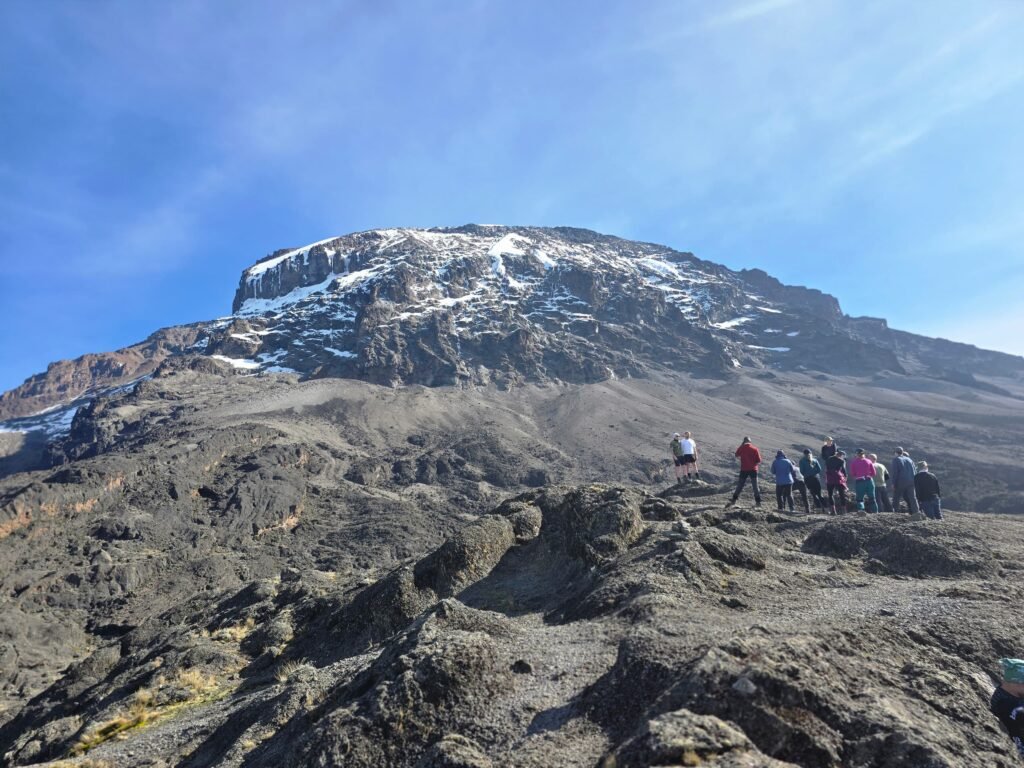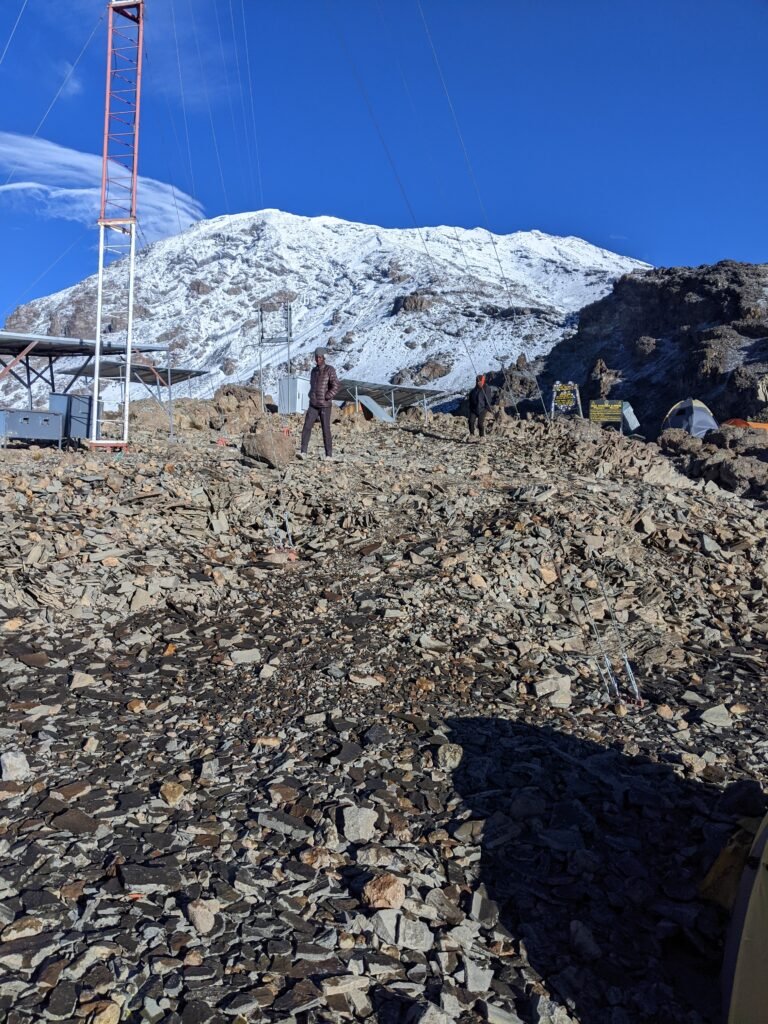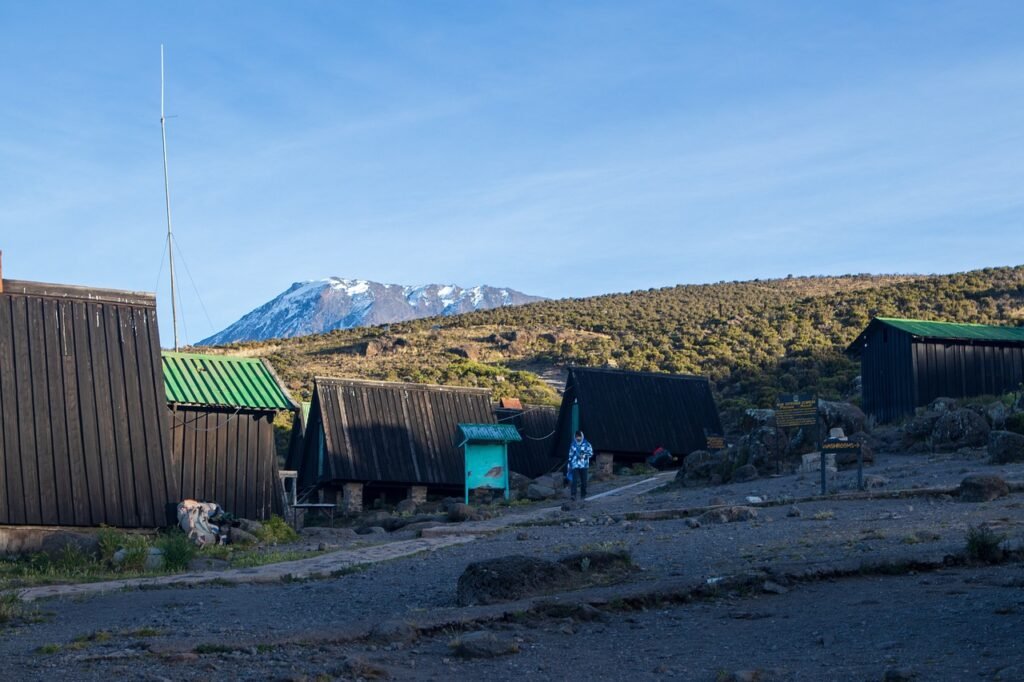Overview of the lemosho route
This route approaches Mount Kilimanjaro from the west and offers a unique opportunity to visit the Shira Plateau, including Cathedral Peak and Shira Caldera. The Lemosho Route crosses from Shira Ridge to Shira 2 Camp on a pleasant hike.
Climbers experience low traffic until the route merges with the Machame Route. From there, Lemosho continues along the same path as Machame through Lava Tower.
The minimum duration for this route is 7 days, though 8 days is recommended to allow better acclimatization and increase the chances of reaching the summit.
Like Machame, Lemosho is scenically spectacular and varied, making it highly recommended. The route is also rich in wildlife, with chances to see elephants, buffalo, eland, and even lions that migrate from the Longido Game Controlled Areas during the dry season to forage.
lemosho route 8- Days Itinerary
Day 1: Moshi to Lemosho Gate to Big Tree Campsite.
Elevation: 1,200m to 1,950m to 2,850m
Distance: 9km
Hiking Time: 3–4 hours
Habitat: Montane Forest
We will pick you up from your hotel in Moshi or Arusha and meet your hiking team before starting the journey to Lemosho Gate. Upon arrival, you will complete the registration process. After registration, lunch will be provided, and you’ll be ready to begin your hike.
From this point, you will trek through undisturbed Montane Forest, beautifully decorated with Black and White Colobus Monkeys, heading towards Mti Mkubwa Camp. Here, you will enjoy dinner and spend the night.
Day 2: Big tree campsite to Shira one campsite
Elevation (m): 2850m to 3500m
Distance: 13km
Hiking Time: 8 hours
Habitat: Moorland and Heather Land
On this day, you will gain over 650m as an acclimatization point by starting your walk across a beautiful valley outside the Shira Caldera Rim (3600m). After a few hours, you will reach the Shira Caldera.
A high-altitude desert, Shira is one of the three peaks that erupted in the Kilimanjaro ecosystem. The peak later collapsed and formed a crater, which eventually became filled with lava flow from Kibo Peak. Its rim has been eroded and blasted away by weather and volcanic action.
Finally, you will camp and overnight at 3500m elevation at the Shira One Campsite.
Day 3: Shira one campsite to Shira two campsite
Elevation: 3500m to 3800m
Distance: 7km
Hiking time: 5-6 hours
Habitat: Moorland and rocky
This day you will trek to east across Shira plateau, visiting the cathedral peak (3850 m) for
acclimatization. You will have the opportunity for spectacular photography and enjoy the view of Mount Meru and Kibo Peak. Then continue trekking to Shira two camps, where we will stay for dinner
and an overnight place.
Day 4: Shira two campsite to Barranco Camp
Elevation: 3,800m to 4,000m
Distance: 11km
Hiking Time: 7 hours
Habitat: Moorland and Desert
This is another great day for acclimatization. You will ascend to Lava Tower (4,600m), where you will stop for lunch. Afterward, you will descend to Barranco Camp (3,950m). This ascent and descent technique is ideal for helping your body adjust to the increasing altitude.
Upon arrival at Barranco Camp, you will enjoy dinner and spend the night, preparing for the next day’s trek.
Day 5: Baranco To Karanga Camp
Elevation: 3,960m to 4,035m
Distance: 7km
Hiking Time: 4 hours
Habitat: Moorland and Desert
This is another exciting day as you begin by ascending the Barranco Wall, which offers exhilarating views of the valley below. Although the climb can be a bit challenging, it is a rewarding experience.
After conquering the wall, the trail continues toward Karanga Camp, where you will set up camp, enjoy dinner, and spend the night as you prepare for the next day’s ascent.
Day 6: Karanga Campsite to Barafu Campsite
Elevation: 3900m to 4620m.
Distance: 8 km.
Hiking time: 3-4 hours.
Habitat: Alpine Desert.
On this day, the trek up to the Barafu ridge campsite is tough because of altitude. The walk takes few hours because of the short distance but is steep needing a slow pace to avoid fatique. You will trek across an alpine desert. Chances are that a strong, cold wind will be blowing from Kibo peak and its ice. You will have an early dinner at 1700hrs then rest until midnight when we you will attack the summit.
Day 7: Barafu Camp/ Uhuru Peak/ Mweka Camp
Elevation: 4620m to 5895m to 3100m
Distance: 15km
Hiking time: 10 – 12 hours
Habitat: Desert and ice.
Wake at midnight to a light breakfast and then prepare for your summit ascent. The goal is to climb before dawn so that you can reach Uhuru Peak shortly before or after sunrise. The trails are a series of switchbacks up steep scree or possibly snow, and reach Stella Point on the crater rim at 5,861 m/18,640 ft between 4 and 5 AM. At this point you will be having the views of the fabled crater and its glaciers facing you. Then after 1 hour of hiking along the Kibo crater rim near the celebrated snows takes you to Kilimanjaro true summit, Uhuru Peak. Here you will spend some times for taking photo’s but it will depend on how you feel. After your summit activities done, you will descend back to the Barafu campsite, for lunch, rest, collect your equipment, and continue down through moorland and heath zone to Mweka campsite. Dinner and overnight at Mweka campsite
Day 8: Mweka campsite to Mweka gate.
Elevation: 3100m to 1700m
Distance: 9km
Descending time: 3-4 hours
Habitat: Montane Forest.
Today is your last day on the mountain. After breakfast you will descend down to Mweka park gate walking across Montane Forest. This descent will take 3-4 hours. Here at the gate, you will sign out and get ready to board the vehicle ready for the transfer back to the hotel for your certificate presentation and a well-deserved celebration
- 2 Nights hotel accommodation in Moshi
- 8 Days Park Entrance fees
- 7 nights camping fees
- 8 Days rescue fees
- Food, 3 meals everyday on the mountain refers the menu below.
- Camping equipment these are: Sleeping tents, Mess tents, Kitchen tents, Tables and Chairs
- Salaries to all porters, Cook, Assistant Guide and Chief guide
- Transfer to Lemosho gate and return to Moshi after the climb
- Small company first aid kit.
- Oxygen tank supply.
- Oxymeter
- Tip for the supporting crew.
- Personal things
- Food and drinks at your hotel.
- Any flight.
- Transfer from JRO to Hotel and return
- Taxi driver service
- Health insurance
Regarding to what you should bring in terms of your personal equipment’s get the list below:
- One sleeping bag
- One sleeping Mat
- One pair of climbing poles/sticks
- One large Duffle bag with straps / rucksack
- One head lamp / Flashlight + Batteries
- Water bottle - 2 liters x 2 bottle or camel bag bottle
- Camera / sufficient memory/film
- Purification water Tablets / Water Pump
- One pair sunglasses
- One pair of climbing hiking boots
- One pair of tennis Shoes - to begin climb/side walks
- Socks - thin and thick pairs
- One warm trousers
- Woolen Trousers and jacket with zippers
- Water proof / wind trousers & jackets
- Warm Sweater for cold nights
- Inner slacks - long Johns & Top
- Long / short sleeve T-shirt with zippers
- Pajamas and hand towel
- Shade Sun hat or cap
- Balaclava
- Gaiters
- Mitten / Gloves - poly thermal





